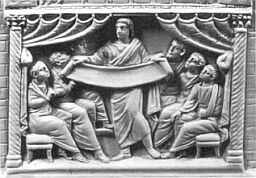 The Gospel of Marcion, continues Paul Louis Couchoud, was fascinating reading but received outside Marcionite churches only after appropriate corrections. The first of these was in Alexandria by the gnostic philosopher Basilides.
The Gospel of Marcion, continues Paul Louis Couchoud, was fascinating reading but received outside Marcionite churches only after appropriate corrections. The first of these was in Alexandria by the gnostic philosopher Basilides.
The works of Basilides have been lost. We know they consisted of 24 books making up his Gospel and Commentaries. From Hegemonius we know the gospel of Basilides included Marcion’s parable of Dives [the Rich Man] and Lazarus. In Marcion’s gospel this parable addressed the Jews exclusively. The place of torment and place of refreshment (for those who obey the Law and Prophets) were both in “Hell”. Heaven is the bosom reserved only for those who belong to the Good God (who is greater than the Jewish creator god).
Basilides’ gospel did not have Jesus actually crucified. For Basilides, who may have been influenced by Buddhism, all suffering is the consequence of sin, even if for sins committed in a former life.
Basilides taught that Jesus somehow was confused with Simon of Cyrene and it was this Simon who was crucified in his place. Jesus, being supernaturally related to God or Mind was able to change his appearance at will, and so escaped crucifixion and was taken, laughing at how he had deceived mere mortals, to heaven. Thus the Pauline theme of the mocked Archontes/Rulers was maintained, but in the process the crucifixion was denied — a denial we see repeated in the Acts of John and in the Koran of Islam.
So Basilides was extending the original notion found in Marcin’s gospel that Jesus had no real human body.
Basilides is apparently responsible for the institution of the festival of the Epiphany of Jesus and of his Baptism on January 6.
This makes us think that according to Basilides the manifestation of Jesus as a god took place at a baptism similar to the water festival celebrated at Alexandria on January 6, but in honour of Osiris. (ppp. 169-170)
Next post, the Roman reaction: the Gospel of Mark

